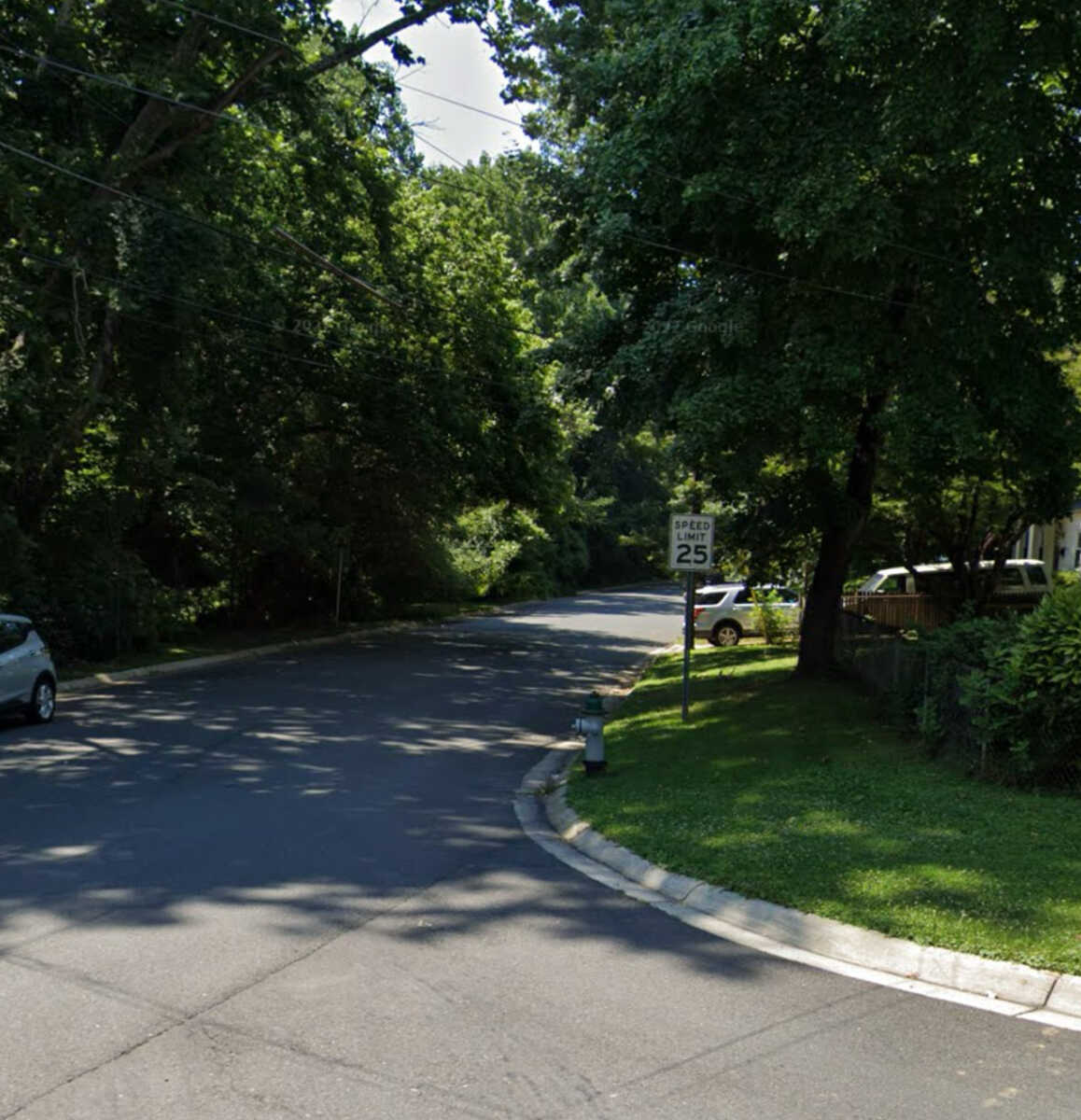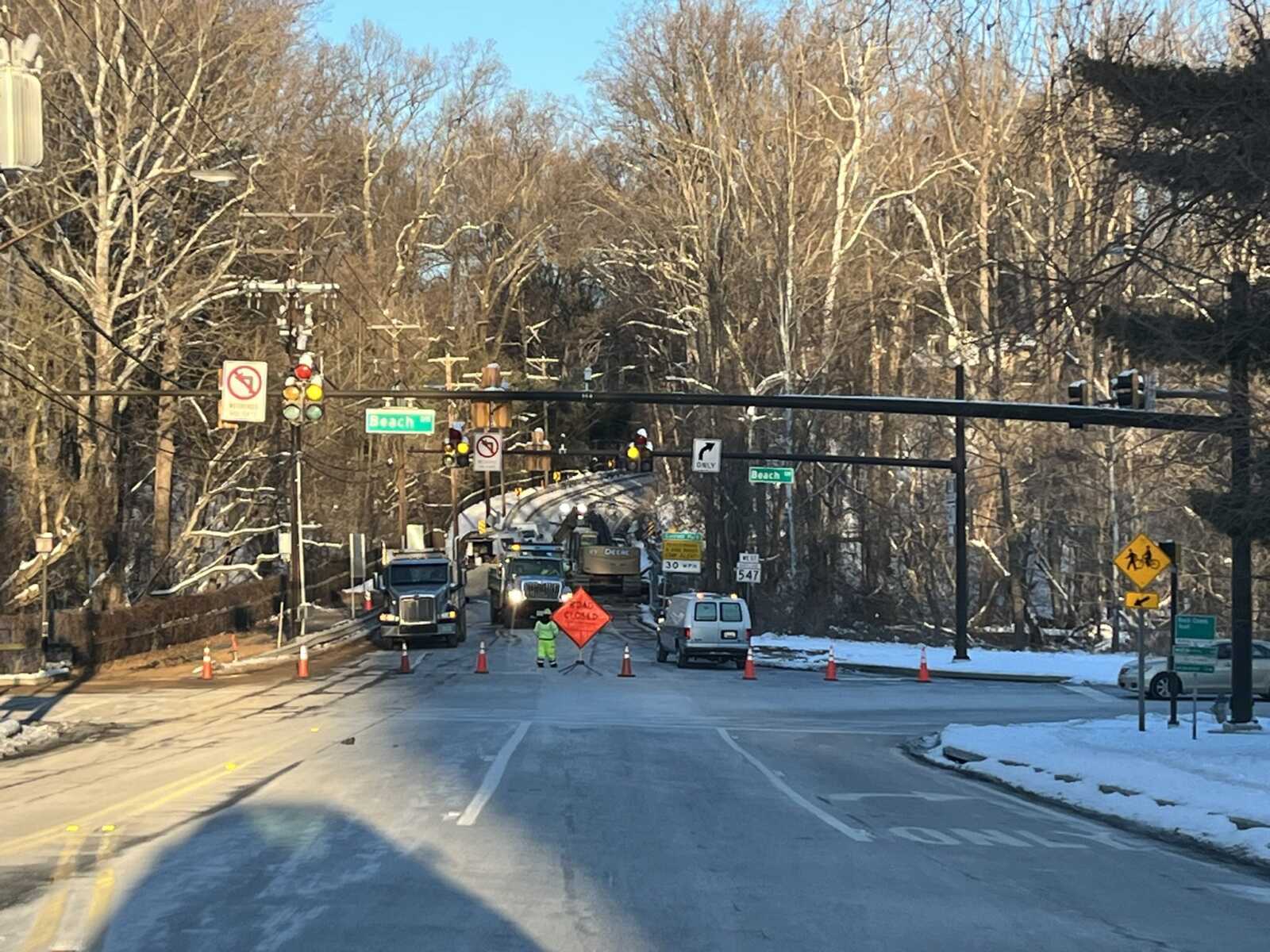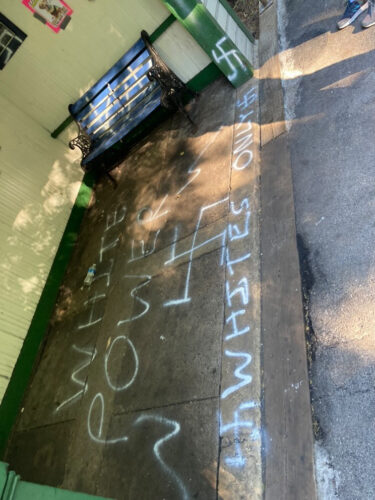
The Montgomery County Police Department (MCPD) responded to the 4100 block of Garrett Park Rd. in Silver Spring for the sound of shots at approximately 5:30pm on Saturday evening. Police tell us that upon arrival officers observed a vehicle leaving the area at a high rate of speed and spoke to multiple witnesses who observed a male shooting a firearm into the woods.

Update: The repairs have been made and the road is now open.
A water main break keeps Knowles Ave closed between Garrett Park and Kensington on Sunday. WSSC crews worked throughout the night and have significant work to do to repair roadway.
The Garrett Park commuter train station on Rokebay Ave in Garrett Park was vandalized Sunday night/Monday morning with “white power” and other racist slogans and images spray painted throughout the building. According to a representative from the Town of Garrett Park, Montgomery County Police, as well as CSX, which owns the station, have been notified.
The Garrett Park station is served by limited trains on the MARC Brunswick Line, some of which stop at the station and some of which are flag stops, according to MARC.
Last week, antisemitic flyers with white supremacist slogans were posted on a bus stop in the heart of the Kemp Mill Orthodox Jewish Community at the corner of Arcola Avenue and Lamberton Streets in Kemp Mill. We will post an update when more information becomes available.
Photos of Garrett Station below:


Garrett Park is a small, incorporated town in Montgomery County located in a sylvan setting next to Rock Creek Park. Garrett Park was incorporated in 1898 and has an active town government and resident-directed organizations. The town is laid out as an English village with winding, tree-lined streets and a variety of housing types. It’s on the National Register of Historic Places and as an Arboretum (established in 1977), has a Arboretum Committee to manage the health and variety of trees. In 1962, by referendum Garrett Park became the first Nuclear Free Zone in the United States. Below you’ll see a brief history of the town leading up to 1898 By Paul Edlund, former mayor of Garrett Park (1990-1996), via the official website of the Town of Garrett Park
By the time of its incorporation as a Town in 1898, Garrett Park was a busy small town with a population of over a hundred and containing more than 30 buildings. Much of life centered around the trains and the station, the railroad being the only public transportation in the early years. The trains to and from Washington were numerous, as many as nine a day into the city, with train service on Saturdays and Sundays.
It seems clear that through much of the 1890s, the sounds of construction, hammering and sawing and all that went with them, continued unabated in Garrett Park. During the 1890s, 14 houses as well as a one-room schoolhouse were constructed on Kenilworth Avenue, making this street the most heavily populated at the time, being the location of nearly half the houses in Town. Seven houses were built on Waverly, six on Montrose, five on Keswick, and one lone house, long known as the Cleveland house, on Rokeby.
In 1893, the Baltimore and Ohio Railroad build a train station in Town, one quite similar to that built in Kensington in 1890, the only one that still stands today. The sights and sounds of horse-drawn wagons, bringing from the B&O siding the building materials to be converted to homes, must also have been pervasive. The unloading of freight cars on the Town siding proceeded at a regular rate. A load of coal weighing 31,984 pounds was delivered on November 3, 1891: freight charge $9.60. Two days later, 192 feet of lumber weighing 600 pounds was unloaded: freight charge 30¢! Facing the Garrett Park station was the building now called Penn Place, but which was at that time called Hardesty and Crehan’s store. The first telephone in Town was installed there in 1896, and according to the Montgomery Press, “the Park people have already begun to realize what a convenience it is and how it fills a long felt want.”
The Garrett Park Chapel (today’s Town Hall) was opened in July 1897. The Montgomery Press had reported that the building was to cost $1,100, stating “we are anticipating a very pretentious building.” We wouldn’t agree with such a statement today, of course!
By 1898 the Town had a solid architectural base with its Victorian homes. Trees were not as evident as they would become, although the planting of new ones went forward with considerable zeal. Today, people and buildings have increased tenfold, and there seems little more room for growth. The Town remains a small town, both in its size and atmosphere, much to our satisfaction and great pleasure.
Video Walking Tour of Garrett Park: Paths to the Present, Montgomery Connections History Project. (By Montgomery County Cable, run time is 15.02 minutes)
‘Monuments: Creative Forces’ is a Hit at Strathmore
This month Strathmore welcomed us all back to their 16-acre campus to experience Monuments: Creative Forces (click to get your reserved time ticket), a campus-wide outdoor art installation by Australian artist Craig Walsh.
The photos by Adam Brockett show how truly captivating the art that is currently in our backyard truly is. The faces are 8 minute loops that move while they are projected onto trees.
Per Strathmore: The exhibition features moving, dimensional video portraits of artists whose work and artistic endeavors are changing the shape of our community in profound ways. Expansive video portraits of these creative heroes, chosen by a diverse panel of community and arts leaders, are projected on to towering trees, transforming them into animated sculptural monuments.
Monuments redefines traditional expectations of public monuments and the selective history represented in our civic spaces. At a time when our nation questions the efficacy of effigy, we’re creating a space for the community to further explore the conversation around monuments and their meaning. The exhibition challenges the traditional concept of monuments to celebrate living, contributing, members of our community.
Monuments is particularly resonant today as Strathmore’s campus becomes a space for safe connection between community and the art that shapes it. “We’re thrilled to be able to honor and celebrate the way these artists are impacting the community,” shares our Artistic Director Joi Brown, “the exhibition allows Strathmore to leverage our entire campus to create a comfortable and socially distant environment for the community to engage with and enjoy the arts during the ongoing pandemic.”
A representational and diverse panel of community and arts leaders focused on work in our region convened to review and select these monumental people to recognize. The panel evaluated the artists, rating them on criteria including how the artist speaks truth to power through their creative work, do they create unity in places of division, and is there something about the artists’ presence or activity in the community that feels “seismic” or “earth-shaking.”
About Craig Walsh
Monuments is the brainchild of internationally acclaimed artist Craig Walsh. Known for his pioneering works, including innovative approaches to projection mapping in unconventional sites, Walsh’s site-responsive works have animated natural environments and features such as trees, rivers, and mountains, as well as public art projects in urban and architectural spaces. Walsh’s work is distinctive for its conceptual underpinnings and deftly woven narrative.
The Experience
All visitors, regardless of ticket time and pay-what-you-can entry option, will experience the entire exhibition. After passing through our contactless scanning station, visitors will move through Strathmore’s campus to view each of 6 dimensional monuments, projected in trees around the perimeter. Directional signs and volunteers will be available to guide visitors along the way, but each group can move at their own comfortable pace and explore various views of each monument. Read more for tips for an ideal visit below.
Photos courtesy of Adam Brockett.




 A tree fell across the railroad tracks at the Garrett Park station this morning.
A tree fell across the railroad tracks at the Garrett Park station this morning.
The commuter rail station is a stop on the MARC train’s Brunswick Line, which normally makes six daily stops at Garrett Park.
The tree blocked the tracks and left the train unable to pass.
Per reader Mary Catherine Allin, “The lights you see are from the Capitol Limited heading to Union Station from Chicago. A helpful neighbor with his chain saw and the train crew were able to clear the tracks so they could get by. They were delayed for maybe an hour.”
Photo courtesy of Instagram user @TommySenior10

